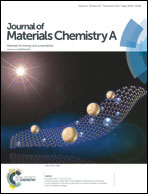Ionothermal confined self-organization for hierarchical porous magnesium borate superstructures as highly efficient adsorbents for dye removal†
Abstract
Three-dimensional (3D) hierarchical porous structures self-organized by one-dimensional (1D) building blocks have attracted considerable attention due to their unique properties and versatile applications. Herein, uniform hierarchical porous MgBO2(OH) superstructures with a microsphere-like profile were synthesized for the first time via a facile ionothermal synthesis (150 °C, 12.0 h) using MgCl2, H3BO3 and NaOH as the raw materials, and N,N-dimethylformamide nitrate ionic liquid as the solvent. The porous MgBO2(OH) microspheres exhibited a specific surface area of 57.22 m2 g−1, 82.4% of which had a diameter within the range of 4.0–6.0 μm. The subsequent mild thermal conversion (600 °C, 12.0 h) gave rise to the hierarchical porous Mg2B2O5 microspheres with high crystallinity and a specific surface area of 24.20 m2 g−1. The synergistic effect of the hydrophilic surfaces of the MgBO2(OH) nanostructures and the ionothermally confined self-organization co-contributed to the formation of the hierarchical porous MgBO2(OH) and Mg2B2O5 superstructures, which were employed as adsorbents for Congo red (CR) in simulated waste water. Both MgBO2(OH) and Mg2B2O5 superstructures exhibited good recyclability and reusability as high efficient adsorbents for dye removal after regeneration. The Langmuir isothermal model well interpreted the adsorption behavior of CR. The intra-particle diffusion model was also well fitted based on the kinetic data, indicating microsphere diffusion as the rate-limiting step. The maximum adsorption capacities, qm, for CR onto the porous MgBO2(OH) and Mg2B2O5 superstructures, which were calculated from the Langmuir isothermal model, were 228.3 and 139.3 mg g−1, respectively. The present ionothermally confined self-organization for the hierarchical porous MgBO2(OH) and Mg2B2O5 superstructures provide new insights into the material chemistry, as well as a controllable ionothermal route for hierarchical borate nanoarchitectures. In addition, these superstructures provide a new platform for dye adsorption, and other potential fields, such as heterogeneous catalysis.


 Please wait while we load your content...
Please wait while we load your content...